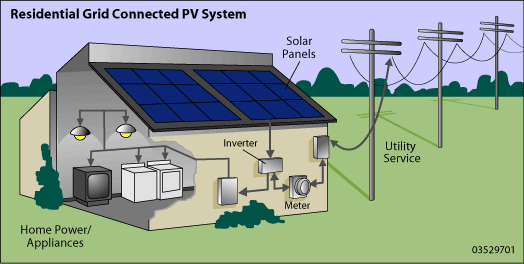Source: U.S. Department of Energy: A Consumer's Guide to Energy Efficiency and Renewable Energy

In the future the utilities may be required to buy back power from your system, if you produce more than you use. Existing regulations do not permit you to send more electricity back to the utility company than you use, but your design consultant will assist you in creating a system that reduces your electric bill to the lowest level possible
Net Metering: Net metering is an agreement between a utility company and you, the customer. The agreement states that the utility will credit your account for excess electricity you produce and feed into the utility grid.
Typically the utility will install a Time-of-Use Meter so that you can be credited for power at different rates; peak rates and off peak rates. Rates are dependent on the time of day, day of the week, and month of the year. Peak periods are typically week day summer afternoons. When you send power to the utility grid during peak times, you will receive a credit at the higher, peak rate. When you draw on your credit at off peak times your account will be debited at off peak rates.
Most people will benefit by installing the time-of-use meter. Keep in mind that you will receive a credit from the utility when you are generating more power than you are using. If all of the power being produced by your solar energy system is immediately being used, your meter will not "spin backwards".
In the future the utilities may be required to buy back power from your system, if you produce more than you use. Existing regulations do not permit you to send more electricity back to the utility company than you use, but your design consultant will assist you in creating a system that reduces your electric bill to the lowest level possible.
The basic building blocks of a PV system, solar cells, consist of semiconductor materials. When sunlight is absorbed by these materials, the solar energy knocks electrons loose from their atoms. This phenomenon is called the "photoelectric effect." These free electrons then travel into a circuit built into the solar cell to form electrical current. Only sunlight of certain wavelengths will work efficiently to create electricity. PV systems can still produce electricity on cloudy days, but not as much as on a sunny day.
The basic PV or solar cell typically produces only a small amount of power. To produce more power, solar cells (about 40) can be interconnected to form panels or modules. PV modules range in output from 10 to 300 watts. If more power is needed, several modules can be installed on a building or at ground level in a rack to form a PV array.
PV arrays can be mounted at a fixed angle facing south, or they can be mounted on a tracking device that follows the sun, allowing them to capture the most sunlight over the course of a day. Note: Studies have shown that tracking arrays in high intensity sunshine areas like Southern California do not provide enough extra energy to justify the additional installation and maintenance costs of the tracking hardware.
Because of their modularity, PV systems can be designed to meet any electrical requirement, no matter how large or how small. You can connect them to an electric distribution system (grid-connected), or they can stand alone (off-grid). Off-grid systems are normally only permitted in remote areas that have no electrical provider.